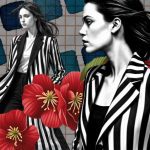Unraveling the Seasons: The Art and Strategy Behind Fashion's Schedule

As I dive deeper into my wearable art projects, my curiosity about the fashion industry’s inner workings grows. Recently, while crafting a post on the pattern trends for Spring and Summer 2024, I found myself pondering the scheduled nature of fashion trends and collections. Typically, designers focus on two seasons at a time, and I’ve always wondered why.
Initially, I imagined it as a friendly rivalry among fashion designers and trend forecasters, racing to unveil their latest creations and dictate the next big thing. However, I’ve come to realize there are several well-founded reasons behind the industry’s scheduling practices:
Climate and Consumer Demand: Fashion is inherently linked to the changing seasons. By merging two consecutive seasons, like Spring and Summer, designers can produce collections that are not only relevant for an extended time but also cater to similar climatic conditions.
Production Cycle: The fashion industry’s timeline from design to distribution is lengthy. Designers need ample time to brainstorm, produce, and deliver their lines well ahead of the actual selling season. Combining seasons offers them a wider window to market their creations.
Retail Scheduling: Retailers synchronize their inventories with these collections, making two main seasonal launches practical for planning their stock, marketing, and sales strategies with greater efficiency.
Fashion Weeks and Trade Shows: These crucial events, occurring twice yearly, are instrumental in setting the forthcoming seasons’ trends. The bi-annual schedule perfectly complements the Spring/Summer and Fall/Winter collections’ rhythm.
Consumer Expectations and Tradition: This bi-annual schedule has become a tradition, with consumers looking forward to and expecting new releases in line with this cycle.
Marketing and Hype: Launching new collections semi-annually generates excitement and keeps consumers engaged with brands, boosting sales.
Lately, the industry has been moving towards more frequent releases, seasonless collections, or focusing on sustainability, responding to evolving consumer preferences and environmental concerns.
For those keen to delve deeper into the fashion calendar and its nuances, here are some excellent resources:
- Fashion United: Offers insights into the workings of fashion seasons, the timing of shows and collections, and the challenges arising from the misalignment with actual seasons.
- The Tech Fashionista: Discusses the historical backdrop and modern trends in fashion seasons, including the shift towards more adaptable, seasonless collections.
- Meet Your Wardrobe: Provides a thorough explanation of fashion seasons, their significance in the retail calendar, and how fashion weeks are transforming.
In summary, the fashion calendar is a sophisticated system shaped by historical practices, climatic changes, and industry rhythms. Despite facing challenges and a move towards more fluid fashion cycles, it continues to be a cornerstone of the industry’s framework.






0 Comments